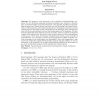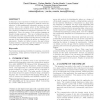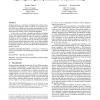367 search results - page 27 / 74 » Adapting functional programs to higher order logic |
ICDM
2005
IEEE
14 years 2 months ago
2005
IEEE
Bayesian Network (BN) is a powerful network model, which represents a set of variables in the domain and provides the probabilistic relationships among them. But BN can handle dis...
JUCS
2006
13 years 8 months ago
2006
Abstract: We present a novel approach to the verification of functional-logic programs. For our verification purposes, equational reasoning is not valid due to the presence of non-...
ERLANG
2003
ACM
14 years 1 months ago
2003
ACM
In this paper, some experiences of using the concurrent functional language Erlang to implement a classical vertical application, a risk management information system, are present...
WCFLP
2005
ACM
14 years 2 months ago
2005
ACM
Program slicing is a well-known technique that extracts from a program those statements which are relevant to a particular criterion. While static slicing does not consider any in...
CEFP
2005
Springer
14 years 2 months ago
2005
Springer
This chapter describes Hume: a functionally-based language for programming with bounded resource usage, including time and space properties. The purpose of the Hume language design...



